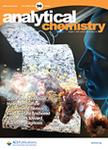版权所有:内蒙古大学图书馆 技术提供:维普资讯• 智图
内蒙古自治区呼和浩特市赛罕区大学西街235号 邮编: 010021

作者机构:China Univ Geosci State Key Lab Biogeol & Environm Geol Wuhan 430078 Peoples R China China Univ Geosci Fac Mat Sci & Chem Wuhan 430078 Peoples R China Hubei Key Lab Yangtze Catchment Environm Aquat Sci Wuhan 430078 Peoples R China
出 版 物:《ANALYTICAL CHEMISTRY》 (Anal. Chem.)
年 卷 期:2025年第97卷第4期
页 面:2264-2272页
核心收录:
学科分类:081704[工学-应用化学] 07[理学] 08[工学] 0817[工学-化学工程与技术] 070302[理学-分析化学] 0703[理学-化学]
基 金:National Natural Science Foundation of China [22274145, 22061130207] National Natural Science Foundation of China Knowledge Innovation Program of Wuhan Shuguang Project [2023YFF0806200] National Key R&D Program of China
主 题:High performance liquid chromatography
摘 要:A novel method has been developed for the simultaneous online determination of the isotopic compositions of different antimony (Sb) species in a single analytical run using high-performance liquid chromatography (HPLC) coupled with multicollector inductively coupled plasma mass spectrometry (MC-ICPMS), with hydride generation (HG) serving as the interface. Various parameters affecting the precision of Sb isotope analysis including HG conditions, transient signal processing methods and peak integration windows, were optimized. The linear regression slope method and a 100% peak integration window provided the optimal precision. Under optimized conditions, our method achieved external 2SD precisions better than 0.05 parts per thousand for both Sb(III) and Sb(V), with minimal consumption of 0.5 ng for Sb(III) and 5 ng for Sb(V). Furthermore, flow injection (FI) coupled with HG-MC-ICPMS demonstrated precise Sb isotopic analysis with sample requirements as low as 0.25 ng. The proposed methods were validated by analyzing delta 123Sb in synthetic solutions and reference materials. Additionally, it was applied to investigate isotopic fractionation during the reduction of Sb(V) by KI, revealing preferential reduction of the light Sb isotope(121Sb). The isotopic compositions of Sb(V) varied from -0.04- 1.18 parts per thousand, fitting well with a Rayleigh fractionation model and yielding a fractionation factor (alpha Sb(III)-Sb(V)) of 0.99831. In summary, this approach enables high precision isotopic analysis of Sb(III) and Sb(V) simultaneously with reduced sample consumption, providing a powerful tool for investigating Sb isotopic fractionation in various environmental processes and advancing our understanding of the Sb biogeochemical cycle.